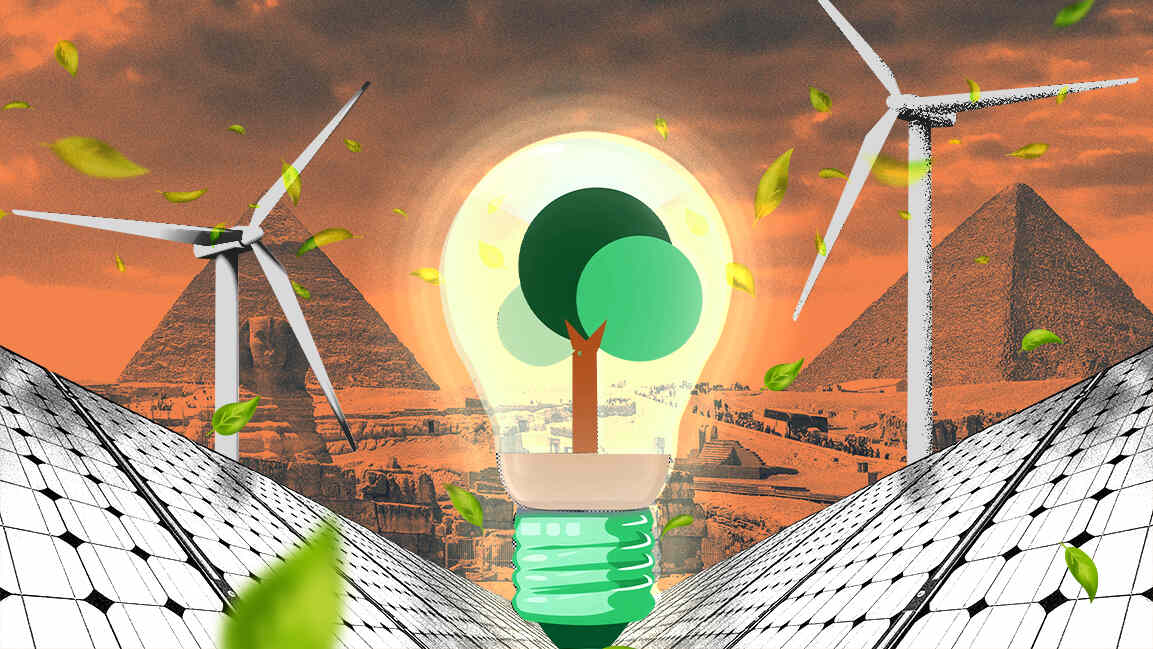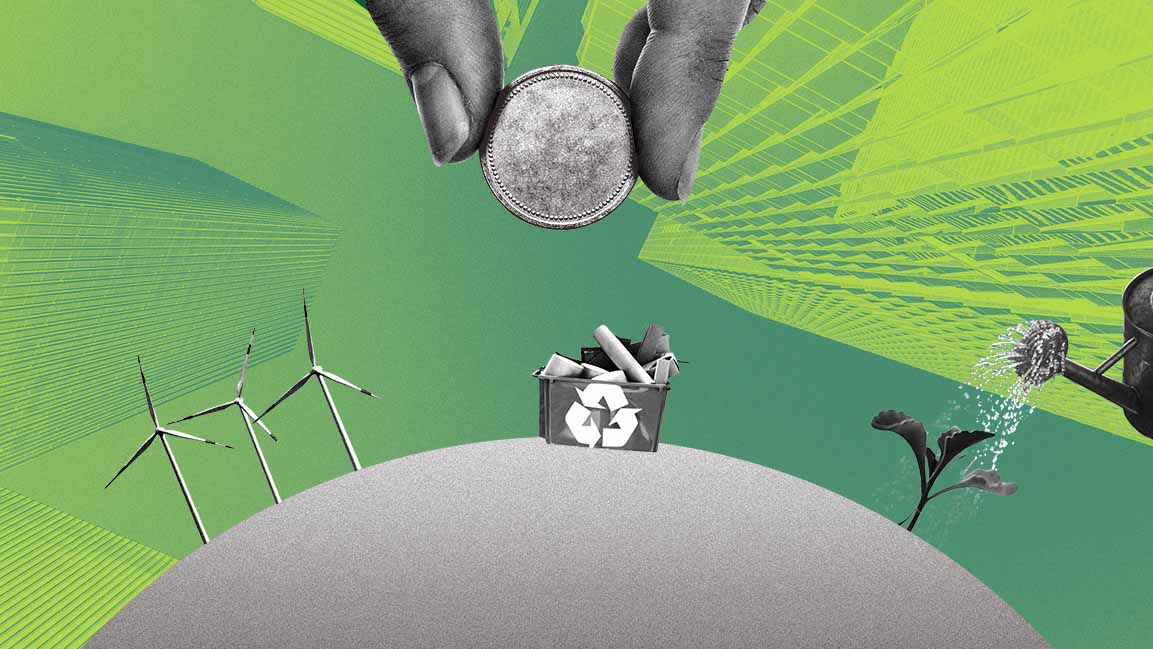- | 9:00 am
Renewable energy dominates Egypt’s new investment strategy. Will it boost the economy?
Experts say focusing on green investment can help Egypt cut fossil fuel use, attract FDI, boost exports, support key sectors, and create jobs

Egypt is making renewable energy the core of its latest investment strategy, aiming to establish itself as a key regional energy hub.
In a recent strategy meeting, Planning Minister Rania al-Mashat and Electricity Minister Mahmoud Essmat outlined the country’s 2025-26 energy investment priorities, strongly focusing on boosting clean energy capacity and attracting private sector participation.
The government aims to generate 42% of its installed power capacity from renewables by 2030 and reach 12,000 megawatts by 2026, building on legislative reforms and infrastructure upgrades to drive sustainable growth and carbon reduction.
However, the country still faces various economic challenges that could hinder its transformation. Last year, the Egyptian pound fell to a record low of 70 to the US dollar on the black market. A turning point came in March when the Central Bank of Egypt (CBE) announced a free float of the currency, allowing it to stabilize at 50.92.
Egypt’s outlook is improving this year, with the country’s economy showing signs of recovery and projected GDP growth of 4.7% for 2025–2026, surpassing the IMF’s earlier forecast.
Despite the improvement, economic stability is still far away. So, are Egypt’s energy ambitions feasible?
RENEWABLE ENERGY STRATEGY
Khalid Salmi, Senior Expert in Sustainable Energy Management at the Regional Center for Renewable Energy and Energy Efficiency (RCREEE), describes Egypt’s renewable energy strategy as combining policy direction and investment incentives.
He points to the government’s Integrated Sustainable Energy Strategy (ISES) 2035, which recently accelerated its 42% renewable energy target to 2030—five years ahead of schedule. Salmi notes that meeting this goal will require international support, particularly given the country’s ongoing energy challenges.
“This policy clarity, combined with Egypt’s commitment to international climate goals, has created a stable and attractive environment for investment,” he says.
He highlights public-private partnerships—such as those seen in the Benban Solar Park—as examples of how Egypt is effectively attracting private capital into large-scale renewable projects.
“International financial institutions such as the EBRD, IFC, and AfDB have also played a vital role by offering concessional financing and risk guarantees, helping to mobilize billions in clean energy investment.”
“This coordinated approach ensures that government policy and market forces are aligned toward accelerating Egypt’s clean energy transition,” Salmi adds.
Egypt already has the potential to become one of the largest renewable energy hubs, reflected in its growing energy project portfolio.
Kholoud Nasr, an economic researcher at Egypt’s Information and Decision Support Center (IDSC), points to several key initiatives, starting with the Benban Solar Park, one of the world’s largest solar energy complexes. The facility includes over 30 solar plants with a combined capacity of up to 1.8 GW.
The country is also developing new wind farms in the Gulf of Suez with capacities reaching up to 2 GW and expanding the Gabal El-Zeit Wind Farm (Phase II), one of the largest in Africa.
Regarding green hydrogen, Egypt has signed multiple MoUs to establish green hydrogen and green ammonia production facilities within the Suez Canal Economic Zone. These partnerships involve companies, including Norway’s Scatec and Germany’s DHL.
In addition, the Egypt-Europe Electricity Interconnection Project links Egypt’s electricity grid with Greece and Cyprus via the EuroAfrica Interconnector. The project aims to supply clean energy to Europe, further reinforcing Egypt’s position as a regional energy hub.
DRIVERS OF STRATEGIC SHIFTS
Nasr says multiple factors drive Egypt’s strategic pivot toward prioritizing renewable energy, including the country’s focus on sustainable energy and cost-saving goals across several areas.
“In the long run, investing in renewables offers substantial savings compared to continued reliance on fossil fuels.”
She explains that one key cost-cutting measure is reducing Egypt’s reliance on fossil fuels, whose rising prices and volatility strain public finances. Renewables help ease this burden and shield the economy from global shocks.
Nasr also points to Egypt’s push to attract more foreign direct investment. “Renewable energy is an attractive sector for foreign direct investment, with opportunities to partner with international companies and access green financing from global institutions such as the World Bank and the African Development Bank.”
Further revenue is expected from exporting green hydrogen and clean electricity to Europe and Africa, generating valuable foreign currency.
Nasr adds that renewable energy investment can boost other sectors. “Providing clean, low-cost energy can enhance the growth potential of the industrial sector, particularly industries that rely heavily on energy consumption, such as cement and steel production.”
She also cites gains for tourism and agriculture. “The shift toward renewable energy can improve Egypt’s international image as an environmentally conscious country, boosting the tourism sector by attracting tourists from eco-friendly markets.”
“It can also benefit agriculture through solar-powered irrigation systems, which can lower production costs, improve productivity, and reduce expenses for farmers.”
Beyond its environmental impact, job creation has been one of renewable energy’s most visible benefits, says Salmi. Large-scale projects employ thousands during construction and operation.
“Moreover, the sector is driving the emergence of local value chains, particularly in installation, maintenance, and component assembly.”
He explains that zones like the Suez Canal Economic Zone are drawing green investment and clustering related industries. At the same time, renewables enhance energy security by diversifying the energy mix, cutting fuel imports, and stabilizing electricity prices.
CHALLENGES TO OVERCOME
Despite the significant progress, Egypt still faces several challenges in scaling up its renewable energy ambitions. One of the most pressing issues is upgrading and modernizing the national grid to accommodate variable and decentralized generation. Salmi says, “Many of the country’s most promising solar and wind sites are located far from demand centers, requiring major investments in transmission infrastructure.”
Financing also remains a challenge, particularly for small- and medium-scale projects like rooftop solar and distributed systems, which often lack access to tailored financial products and incentives.
“On a broader scale, while Egypt remains stable, regional geopolitical tensions and global economic fluctuations could impact supply chains and investor confidence,” says Salmi.
“There is also a growing need to build local technical capacity in areas such as energy storage, smart grids, and hydrogen to support the long-term sustainability of the sector.”
Egypt’s economic crisis, rising levels of debt, foreign currency shortages, high inflation rates, a slowdown in private investment, and pressure from the IMF are some of the hurdles the country faces.
Nasr says these challenges impact Egypt’s renewable energy ambitions by affecting project financing, increasing capital costs, posing risks to investor confidence, shifting funding priorities, and reducing government incentives.
SOLUTIONS TO CONSIDER
Nasr believes the Egyptian government should adopt various strategic policy measures to counteract these challenges and boost private sector participation in renewable energy projects. These include improving investment conditions, financing options, and operational efficiency.
She recommends establishing a stable regulatory framework with clear long-term policies and simplified permitting and licensing procedures.
“Streamlining the permitting process and reducing bureaucratic hurdles would make it easier for private companies to enter the market. Faster and more transparent approval processes for renewable energy projects would attract more private sector involvement.”
Nasr also highlights the importance of financial incentives, such as tax exemptions and reductions, to help ease investors’ initial cost burden.
She adds that concessional loans and green bonds could attract investors looking for sustainable opportunities, while feed-in tariffs or long-term power purchase agreements (PPAs) would reduce market risk by ensuring price stability.
According to Nasr, public-private partnerships (PPPs) are key to advancing large-scale projects, with the government offering regulatory support and the private sector contributing capital and expertise. She adds that reducing political and currency risks and risk-sharing mechanisms would further strengthen investor confidence.
In terms of long-term sustainability, Nasr calls for more support for innovation, incentives for R&D, and partnerships to enable technology transfer from more advanced economies, helping build local capacity in areas like energy storage and smart grids.
Finally, better market transparency and education are needed. “Transparent, competitive energy auctions can ensure fair pricing and encourage greater private sector involvement,” Nasr adds.
A FUTURE OUTLOOK
Analysts say Egypt is also well-positioned to become a major renewable energy hub in the MENA region and beyond over the next decade, driven by the continued growth of large-scale solar and wind developments.
“A major area of focus will be green hydrogen,” says Salmi, adding that regional interconnection projects—like the Egypt-Saudi Arabia electricity link and proposed connections to Europe—will facilitate cross-border electricity trade and the export of renewable energy.
At the same time, modernizing the national grid and integrating battery storage and digital technologies will be essential to accommodate a higher share of renewables. Domestically, rooftop solar is also expected to expand with upcoming changes to net metering regulations and new financial incentives.
“Altogether, Egypt’s renewable energy landscape is entering a new phase of maturity, marked by diversification, innovation, and regional leadership.”







































